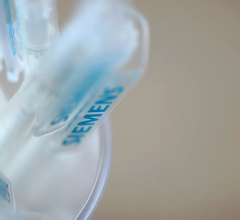
McKesson Cardiology Inventory aids inventory control in the cath lab using a barcode-based system, scanning items as used.
(Editors note: This article was written in 2014, and was updated with more recent information in January 2017.)
Computerized and semi-automated inventory control system technology offers a more efficient way for cardiovascular departments, especially catheterization and electrophysiology (EP) labs, to track what is on their shelves. These systems can help re-order supplies, track the department’s actual costs per procedure and identify new ways to cut costs.
There are three ways inventory control systems can track items — barcode scanning, radiofrequency identification (RFID) tags and drop-down box inventory item selections within reporting systems. Barcode systems require all inventory to be labeled with a sticker with a barcode that corresponds with cataloged items in the inventory control system. The items are then scanned with a laser barcode reader, allowing quick, automated data entry into a system. RFID systems utilize sticker tags similar to anti-theft RFID security tags that set off retail store alarms. All tracked items are tagged and then stocked in RFID cabinets, which automatically read the tags as they enter or leave the cabinet. The cabinets usually have secure entry, requiring a code to be entered or a card to be swiped to unlock the door. This enables automated, accurate accounting of what is on hand in the cabinet, what was removed, when and by whom.
“Inventory control systems will cost money on the on the front end, but you will save money on the backend,” said Marcia Deeb, CVIS coordinator, Washington Hospital, Washington, Pa. “We really know what is on our selves and we only have our re-orders set based in minimum and maximum numbers of what is on hand. You can now see what we are actually using and what it really costs to do a right cath compared to a peripheral cath procedure.”
Over the past year, Washington Hospital has implemented McKesson Cardiology Inventory to optimize the inventory control in the cath lab. It is now phasing it in for the cardiac care unit (CCU). Deeb said the barcode-based system has fit well into the nurses’ workflow, scanning the item as it is used. Previously, nurses used a paper and sticker system to record what they used, but everything had to be manually entered and tracked. She said many times they just eyeballed items on the shelves to decide if they needed to order more items. The new system automatically tracks everything and sends a report to the inventory clerk to reorder supplies that are running low. The system also allows queries to compare costs and supplies used for various procedures.
The McKesson system is tied into billing, which charges patients as items are scanned in via the inventory system. Users can also set up order sets, so numerous items can be bundled into one-click on a drop-down menu for specific procedures.
Florida Hospital, Adventist Health System, adopted the Lumedx Apollo Advance Inventory Module in 2001 to better manage its stocks of cath and EP lab supplies. It is a barcode-based system that allows all supplies to be scanned as they are used or pulled for a procedure. It also uses drop down boxes for common disposables. “It has worked very, very well. Lumedx has really stepped up to the plate, and it most certainly has allowed us to be more efficient,” said Barry Egolf, RN, nurse manager, invasive cardiovascular services.
In addition, four years ago the hospital installed Wavemark RFID cabinets for high-ticket item cath and EP lab supplies, such as stents, balloons and other implantable devices. Since implementation of both inventory tracking systems, Egolf said Florida Hospital has saved millions by better tracking expiration dates, usage, theft prevention, billing capture and knowing exactly what is used for better contract negotiations with vendors.
Florida Hospital has 17 cath labs using the system, including six cardiac, five EP, two interventional radiology, two interventional neurology, one vascular lab and a pediatric hybrid OR. Several other outlying facilities also tie into the inventory system, Egolf said. The primary use of these systems is in the cath labs, where real-time inventory tracking data offers a clear picture of the types and volume of procedures being done and what supplies they require. He said this enables the hospital to reliably predict what supplies are needed on hand at all times and at what level supplies should be reordered to maintain stock. He said this helps Florida Hospital maintain a much leaner inventory.
“Most vendors sell on consignment, so it is free until you use an item, but it does not mean we have the real-estate to store everything,” Egolf said.
Wake Med Health and Hospitals system uses the GE Healthcare’s Centricity Cardiology system with the barcode-based inventory control model in their cath and EP labs. The system currently manages about 3,500 items and categorizes inventory into two types — perpetual or periodical. Items that are perpetual will automatically get ordered when the number on hand gets below a certain number and periodicals are ordered by shelf utilization. Wake Med also interfaced its inventory system with Lawson (a hospital wide materials management system), so all ordering, purchase order generations and receiving are performed in Lawson.
One of the biggest issues in cath lab inventory tracking is that products are stocked based on intuition rather than actual utilization based on clinical demand, said Ken Shastany, RN, MSN, strategic solutions consultant with Cardinal Health inventory management solutions. In the current cost-cutting healthcare environment, he said a growing number of health systems are making informed purchasing decisions using automated inventory management driven by data analytics, which positions hospitals to reduce costs while supporting quality improvement initiatives.
Shatany said hospitals looking to buy these types of systems can help justify ROI by understanding the risks of carrying too much inventory in the cardiovascular suite. He also said accurately managing, tracking and monitoring high-value procedural inventory can help reduce waste. It is also important to learn why automated inventory management and predictive analytics can drive improvements while supporting staff satisfaction, patient care initiatives. Additionally, he explained these systems can help reduce costs by quickly identifying recalled products, products nearing their expirations, and capturing product used during procedures so nothing is lost in billing. These systems can also help reduce staff time by automatic inventory counts, helping re-order supplies, track the department’s actual costs per procedure and identify new ways to cut costs.
Hospitals looking to purchase one of these systems should ensure it can easily be used to data mine.
“You have got to be able to mine the data from the inventory tracking system information or else you are not taking full advantage of the technology,” Egolf said. It also needs to be easy to query the system for specific items, doctors, types of procedures, etc. If a system requires IT to get involved to find the information, he said it makes the system more difficult to use and less likely that inquiries will be made.
Wake Med configured its administrative reports to run automatically for different time frames (daily, weekly, monthly, periodically and annually) to provide insights on their stock level, utilization and costs. Among the reports they created are daily usage, shelf-counts, utilization by physician and cost per case.
A key thing to keep in mind when reviewing systems for purchase is their ease of use, Egolf explained. Not only should it be easy to access, use and query information, but also it is essential for new products to easily be added. In the case of barcoded items, most hospitals use their own specific identification numbers, which need to be combined with vendors’ barcodes so they can be scanned in properly. The more difficult this is to do, the less user-friendly the system, he said.
“As an administrator, you need the system to be malleable to meet the needs of your unique hospital,” Egolf explained.
Another important thing to keep in mind is the need to establish workflow with the inventory control system. Egolf said someone needs to enter new inventory into the system and monitor supply levels and reorder items.
Another key function to look for when shopping for these systems is to ensure it easily interfaces via HL7 with other key systems, such as Admission, Discharge and Transfer (ADT), hospital information systems (HIS) and the cardiovascular information system (CVIS).
All the hospitals in the same system should use the same inventory control software for consistency and to track usage and workflow in an apples-to-apples comparison. Deeb said this makes entering new products into inventory easier, since it only needs to be entered once.
While these systems offer the advantage of automation, Egolf warns there are limits and some manual oversight is needed, especially if bundling supplies for specific procedures. “You have to be careful not to get too automated, because you may charge for things you are not using,” he said.
“Vendors also need to be a partner in the implementation and walk you through the process,” Deeb added.
Register for an upcoming WEBINAR: Steps to Rejuvenate Cath Lab Inventory Management, Thursday, Feb. 23, 2017, at 2 p.m. Eastern.
View an infographic on how to build a business case for purchasing an inventory management system.



 November 14, 2025
November 14, 2025 









